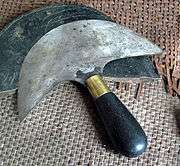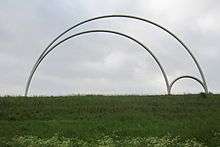Arbelos

In geometry, an arbelos is a plane region bounded by three semicircles connected at the corners, all on the same side of a straight line (the baseline) that contains their diameters.[1]
The earliest known reference to this figure is in the Book of Lemmas, where some of its mathematical properties are stated as Propositions 4 through 8.[2]
Properties
Two of the semicircles are necessarily concave, with arbitrary diameters a and b; the third semicircle is convex, with diameter a+b.[1]

Area
The area of the arbelos is equal to the area of a circle with diameter .
Proof: For the proof, reflect the line through the points and , and observe that twice the area of the arbelos is what remains when the areas of the two smaller circles (with diameters ) are subtracted from the area of the large circle (with diameter ). Since the area of a circle is proportional to the square of the diameter (Euclid's Elements, Book XII, Proposition 2; we do not need to know that the constant of proportionality is ), the problem reduces to showing that . The length equals the sum of the lengths and , so this equation simplifies algebraically to the statement that . Thus the claim is that the length of the segment is the geometric mean of the lengths of the segments and . Now (see Figure) the triangle , being inscribed in the semicircle, has a right angle at the point (Euclid, Book III, Proposition 31), and consequently is indeed a "mean proportional" between and (Euclid, Book VI, Proposition 8, Porism). This proof approximates the ancient Greek argument; one many find the idea implemented as a proof without words.[3]
Rectangle
Let and be the points where the segments and intersect the semicircles and , respectively. The quadrilateral is actually a rectangle.
- Proof: The angles , , and are right angles because they are inscribed in semicircles (by Thales' theorem). The quadrilateral therefore has three right angles, so it is a rectangle. Q.E.D.
Tangents
The line is tangent to semicircle at and semicircle at .
- Proof: Since angle BDA is a right angle, angle DBA equals π/2 minus angle DAB. However, angle DAH also equals π/2 minus angle DAB (since angle HAB is a right angle). Therefore triangles DBA and DAH are similar. Therefore angle DIA equals angle DOH, where I is the midpoint of BA and O is the midpoint of AH. But AOH is a straight line, so angle DOH and DOA are supplementary angles. Therefore the sum of angles DIA and DOA is π. Angle IAO is a right angle. The sum of the angles in any quadrilateral is 2π, so in quadrilateral IDOA, angle IDO must be a right angle. But ADHE is a rectangle, so the midpoint O of AH (the rectangle's diagonal) is also the midpoint of DE (the rectangle's other diagonal). As I (defined as the midpoint of BA) is the center of semicircle BA, and angle IDE is a right angle, then DE is tangent to semicircle BA at D. By analogous reasoning DE is tangent to semicircle AC at E. Q.E.D.
Archimedes' circles
The altitude divides the arbelos into two regions, each bounded by a semicircle, a straight line segment, and an arc of the outer semicircle. The circles inscribed in each of these regions, known as the Archimedes' circles of the arbelos, have the same size.
Etymology

The name arbelos comes from Greek ἡ ἄρβηλος he árbēlos or ἄρβυλος árbylos, meaning "shoemaker's knife", a knife used by cobblers from antiquity to the current day, whose blade is said to resemble the geometric figure.
See also

- Archimedes' quadruplets
- Bankoff circle
- Ideal triangle
- Schoch circles
- Schoch line
- Woo circles
- Pappus chain
- Salinon
References
- 1 2 Weisstein, Eric W. "Arbelos". MathWorld.
- ↑ Thomas Little Heath (1897), The Works of Archimedes. Cambridge University Press. Proposition 4 in the Book of Lemmas. Quote: If AB be the diameter of a semicircle and N any point on AB, and if semicircles be described within the first semicircle and having AN, BN as diameters respectively, the figure included between the circumferences of the three semicircles is "what Archimedes called arbelos"; and its area is equal to the circle on PN as diameter, where PN is perpendicular to AB and meets the original semicircle in P. ("Arbelos - the Shoemaker's Knife")
- ↑ Boas, Harold P. (2006). "Reflections on the Arbelos". Mathematical Association of America. 113: 236–249.
Bibliography
- Johnson, R. A. (1960). Advanced Euclidean Geometry: An elementary treatise on the geometry of the triangle and the circle (reprint of 1929 edition by Houghton Miflin ed.). New York: Dover Publications. pp. 116–117. ISBN 978-0-486-46237-0.
- Ogilvy, C. S. (1990). Excursions in Geometry. Dover. pp. 51–54. ISBN 0-486-26530-7.
- Sondow, J. (2012). "The parbelos, a parabolic analog of the arbelos". arXiv:1210.2279
 [math.HO]. American Mathematical Monthly, 120 (2013), 929-935.
[math.HO]. American Mathematical Monthly, 120 (2013), 929-935. - Wells, D. (1991). The Penguin Dictionary of Curious and Interesting Geometry. New York: Penguin Books. pp. 5–6. ISBN 0-14-011813-6.
External links
-
 Media related to Arbelos at Wikimedia Commons
Media related to Arbelos at Wikimedia Commons -
 The dictionary definition of arbelos at Wiktionary
The dictionary definition of arbelos at Wiktionary - Arbelos – Amazing Properties (an interactive diagram illustrating many Arbelos properties) at www.retas.de
- Arbelos at cut-the-knot
- Arbelos and Parbelos at PlanetMath
- L’arbelos. Partie I and Partie II by Hamza Khelif at www.images.math.cnrs.fr of CNRS
- Review of Jonathan Sondow's "The parbelos, a parabolic analog of the arbelos" by Mowaffaq Hajja in Zentralblatt MATH